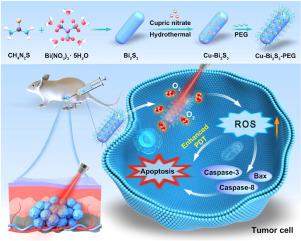铜-Bi2S3 纳米棒促进活性氧生成,用于前列腺癌的光动力疗法
IF 7.1
3区 材料科学
Q1 GREEN & SUSTAINABLE SCIENCE & TECHNOLOGY
引用次数: 0
摘要
光动力疗法(PDT)因其无创伤和针对性强的特点,已成为一种前景广阔的癌症治疗方法。然而,传统光敏剂的复杂合成和活性氧(ROS)生成不足阻碍了光动力疗法的有效性。在这里,我们合成了一种掺铜的 Bi2S3(Cu-Bi2S3)纳米棒,以研究它对 PCa 的局部放疗潜力。与块状 Bi2S3(58%)相比,Cu-Bi2S3 纳米棒能使 87% 的 PC3 细胞在光照下死亡。Bi2S3体相中分散的铜有效抑制了光生电子-空穴对的重组,最终提供了高浓度的电荷载流子。DFT 计算表明,Cu 掺杂会导致 Cu-Bi2S3 的 d 带中心,促进 O2 在 Cu-Bi2S3 上的吸附和活化,从而增强 ROS 的生成。这项工作为 ROS 生成这一紧迫的科学挑战提供了可行的解决方案,而 ROS 生成是提高光导放疗(PDT)治疗癌症疗效的一个关键方面。本文章由计算机程序翻译,如有差异,请以英文原文为准。

Cu-Bi2S3 nanorods promote reactive oxygen species production for photodynamic therapy of prostate cancer
Photodynamic therapy (PDT) has emerged as a promising cancer treatment approach due to its non-invasive and specifically targeted nature. However, the effectiveness of PDT is hindered by the complex synthesis of conventional photosensitizers and inadequate reactive oxygen species (ROS) generation. Here, we synthesize a copper-doped Bi2S3 (Cu-Bi2S3) nanorod to investigate its PDT potential against PCa. Compared with bulk Bi2S3 (58%), Cu-Bi2S3 nanorod caused 87% of PC3 cells to die under light. The dispersed Cu in the Bi2S3 bulk phase effectively inhibits the recombination of photogenerated electron-hole pairs, ultimately providing a high concentration of charge carriers. DFT calculations show that Cu doping causes the d-band center of Cu-Bi2S3, promoting the adsorption and activation of O2 on Cu-Bi2S3 to enhance ROS generation. This work offers a viable solution to the pressing scientific challenge of ROS generation, a key aspect of enhancing the efficacy of PDT for cancer treatment.
求助全文
通过发布文献求助,成功后即可免费获取论文全文。
去求助
来源期刊

Materials Today Sustainability
Multiple-
CiteScore
5.80
自引率
6.40%
发文量
174
审稿时长
32 days
期刊介绍:
Materials Today Sustainability is a multi-disciplinary journal covering all aspects of sustainability through materials science.
With a rapidly increasing population with growing demands, materials science has emerged as a critical discipline toward protecting of the environment and ensuring the long term survival of future generations.
 求助内容:
求助内容: 应助结果提醒方式:
应助结果提醒方式:


